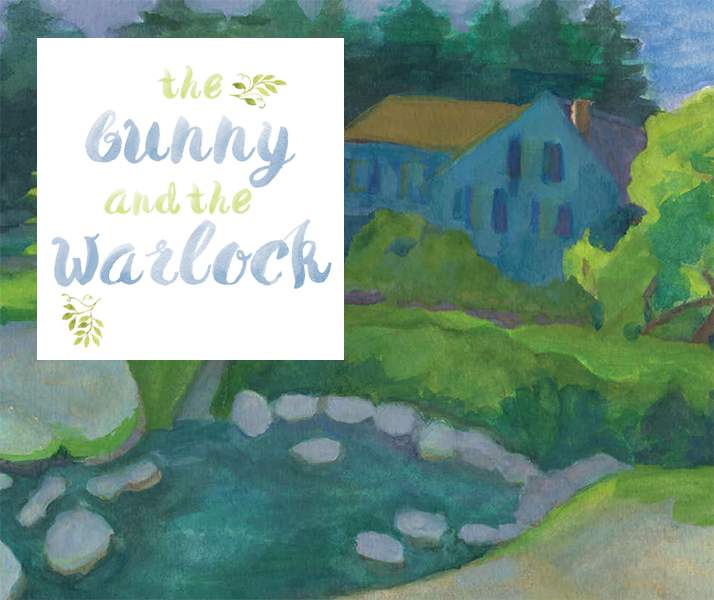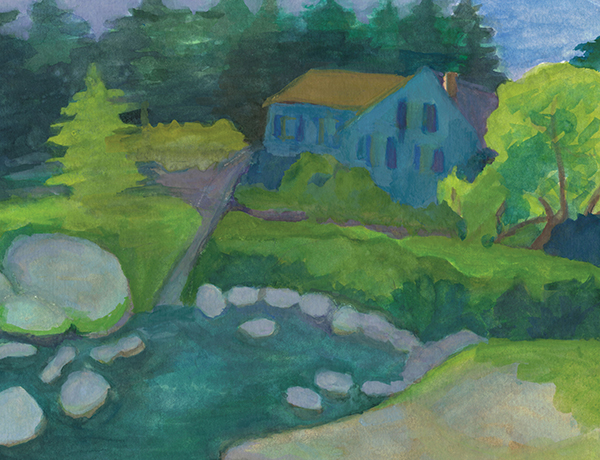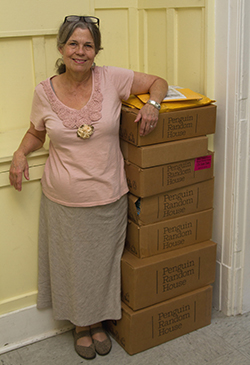
The Bunny and the Warlock
 This foreword, excerpted from a biography of Margaret Wise Brown by Amy Gary, forthcoming from Flatiron Books, was written by James S. Rockefeller Jr., who was engaged to Brown at the time of her death. Brown died at age 42 of an embolism while she was recovering from surgery.
This foreword, excerpted from a biography of Margaret Wise Brown by Amy Gary, forthcoming from Flatiron Books, was written by James S. Rockefeller Jr., who was engaged to Brown at the time of her death. Brown died at age 42 of an embolism while she was recovering from surgery.

The Only House, Margaret Wise Brown’s summer house, on an island off the coast of Maine. Illustration: Halle Dillon ’06
I met Margaret on Cumberland Island, Georgia. This magical place, a step back in time, belonged to my mother’s family and is now a national park. The year was 1952. Margaret was there as a guest of my cousin and I was there outfitting my boat, an old Friendship Sloop, prior to setting out for the South Pacific.
Our eyes first met in my Kentucky cousins’ 1892 mansion with four towering Corinthian columns that rose from a broad lawn studded with giant live oaks. Tall cedars lined the curving oyster shell road leading to the front steps that ascended to a Gone With the Wind porch and a huge front door framed with bronze sconces.
In a room smelling of gun oil and bourbon, she stood next to the gun rack. She looked at me from under her straw-colored hair, with blue-grey eyes that studied you, went through you, while absorbing everything in sight. I knew instantly this was a turning point in my young life. We moved towards each other, the rest of the room faded, and the next morning, shortly after dawn, we were walking on the high dunes overlooking the beach, hand in hand.
With the sunrise she told how she wrote children’s books. Seventy-two to date. The latest was called The Noon Balloon. And she told how the Queen Mother of England kept The Little Fur Book by her bedside. The image of such a regal person keeping something so small and fuzzy so close amused Margaret.
She contemplated the rolling surf and said, “I hope to write something serious one day soon as I have something to say. But I am stuck in my childhood and that raises the devil when one wants to move on.”
In the days to come, I saw how she walked in her own sunrise and sunset, cloaked in the mists of her art that hid the petty daily-doings from sight until she was forced to face them. I remember her saying, “Evening is like morning to me—full of change and renewal and excitement. My low time is from eleven to lunch. At noon, the light is all glaring and blatant and some of the magic seems gone from the day.”
She left from Cumberland for her publishing world all too soon. We wrote each other most every day. I told her about Diana, the pet deer, who hung around the house with her offspring. She wrote back, “The first time I ever held a baby lion cub in my arms it was just like a living toy or a child, a dream come true. And that warm clean smell of that little armful of something I couldn’t believe was real, and the tenderness of that small great beast will always fill me with wonder. Love, Tim.” She was in the process of writing a book for [explorer, author, and filmmaker] Osa Johnson about Osa’s African adventures. Margaret had many nicknames: Tim, the Bunny and the Bunny-no-good. I called her My Bunny and she called me Her Warlock as I looked so fierce in my dark beard.
When she returned to Cumberland for her second visit, I worked on the boat, while she explored the island with all its wildlife. She soon had stories about all of them. Listening to her, one wasn’t sure whether people acted like animals or animals like people. Mr. and Mrs. Toad would come out every evening as we sat on the steps of my grandfather’s house, sipping wine. She asked them what they did in their spare time and if they didn’t get tired sleeping on their tummies, especially if they were full of juicy bugs. I wondered how many books would come out of Cumberland.
A day before she left, we sat in the cupola of the original family mansion, now long deserted. Looking out over the marsh, thinking about the month we had just spent together growing ever closer, it was impossible to foresee a life without her. It was then she said as much to herself as me, “You can never in this world love anyone you love enough.”
We talked of a future together, how I would sail the boat to Panama and she would go to Europe, and then meet me in Panama. We would get married, sail the Pacific and move on to further horizons.
After Cumberland that summer, we spent idyllic days at the Only House, her Maine island paradise. She called it the Only House because “you could see no other light at night.” The gothic little building with its steeply pitched roof and weathered clapboards nestles in a tiny meadow of wild flowers. At the front of the house, a granite wharf juts into the small bay with its little islands, while at the back, a spruce forest forms a curtain to hold the outside world at bay. The only access is by water.
Margaret had written to me about the place. “The song sparrow is singing and a clowning gull is trying to crow like a rooster, cluck like a hen and laugh like a gentle maniac, all at the same time. The house is a boat. Only the weathers and the fog and the times of day and night sail by the house instead of the house sailing away.”
During those halcyon days spent with her there, she showed me the fairy ballroom, a weathered rock clearing, high above Hurricane Sound where the little people danced at midnight. Then there was the magic mouse and his house down a hole beside the path. Of an evening, we would stand in the ballroom and watch the dusk enfold the Sound. Often those eyes of hers would go far away where none but she could go. One evening she turned suddenly and said, “We are born alone. We go through life alone. And we go out alone.”
I will never forget that moment, painful as the words were. She saw herself in a frame where human beings were but one component of a larger whole. To me, walking in the pastures of her imagination was like strolling through an enchanted forest. I saw her as an island in a limitless sea, radiating light further than any lighthouse.
It has been 60 years since those days but over a half-century later, her light is burning ever brighter.
![]()
Margaret Wise Brown Prize in Children’s Literature

Amanda Cockrell with the stack of early submissions for Hollins’ Margaret Wise Brown Prize in Children’s Literature. Photo by David Reep
Even though the deadline for submission isn’t until January 15, 2016, Amanda Cockrell ’69, M.A. ’88 says, “Some publishers have jumped right on it. I expect a lot more in the fall.” Cockrell directs the M.A. and M.F.A. programs in children’s literature.
The $1,000 cash prize, endowed by James S. Rockefeller Jr., recognizes the author of the best text for a picture book published during the previous year (the inaugural prize will be awarded in 2016).
The judges for the first contest are three picture book authors with established careers:
Elissa Haden Guest (M.F.A. ’11/children’s literature), author of the Iris and Walter books, which were recently adapted for the stage at Hollins
William Miller (M.A. ’83/creative writing), author of Tituba, Rent Party Jazz, Zora Hurston and the Chinaberry Tree, Frederick Douglass: The Last Day of Slavery, The Knee-High Man, Madame Zina and the Conjure Woman, and many others
Judy Schachner, author and illustrator of the Skippy Jon Jones books
For more information about the prize, please contact Cockrell at acockrell@hollins.edu.
